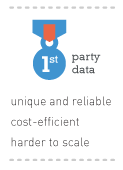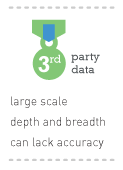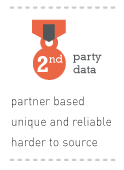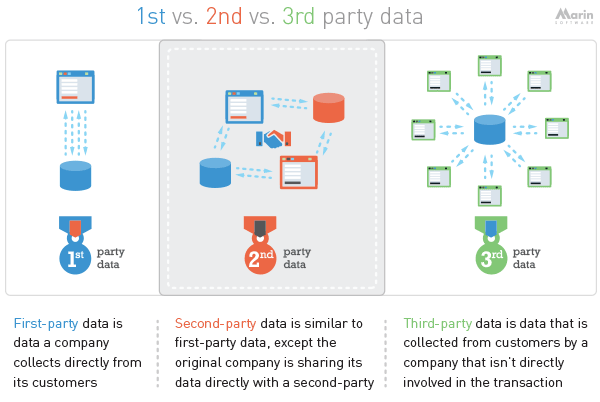The New Data Currency In A Digital World
The list of options on the performance marketing menu has been growing steadily. Whereas search had historically been the primary channel for direct marketers to drive leads and revenue, the array of opportunities has been increasing within the social and display channels, particularly given the rising popularity of retargeting. First-, Second- & Third-Party Data In […]
The list of options on the performance marketing menu has been growing steadily. Whereas search had historically been the primary channel for direct marketers to drive leads and revenue, the array of opportunities has been increasing within the social and display channels, particularly given the rising popularity of retargeting.
First-, Second- & Third-Party Data In A Data Currency World
Accordingly, there’s been a shift in the essential data currency for marketers. Within the search world, that currency has mainly been keyword data. But within the world of display and social, that currency is largely behavior and audience characteristic data.
As a marketer, this involves deriving as much value as possible from your first-party data, but it also means looking across the landscape of third-party data to provide an additional layer of intelligence and color in your targeting efforts. Finally, with the increasing use of data management platforms (DMP) and retargeting platforms, there is a new opportunity to use what’s known as second-party data.
What Is First-Party Data?

- The user data you capture in registrations and sales
- The analytics data you capture from visitor interactions on your websites and mobile apps
- The preferences and usage patterns you learn from customers using your products
- The information that you’re able to collect from the performance of your various marketing campaigns both online and offline
- The ongoing intelligence you gain through your CRM systems
- And more
Essentially, any piece of data that you collect for your own use — unavailable to anyone else — is first-party data.
First-party data is your grandfather’s data. Marketers have long known the value of it; it’s what advertising campaigns and new products have been built upon. Let’s consider the inherent benefits.
First, because the data is collected directly from a business’ customers, it tends to be unique and reliable. Second, unlike third-party data, first-party data tends to be free from the consumer privacy and regulation perspective microscope. Finally, first-party data has the unique benefit of being “free” (not including the costs to set-up and manage data capture).
So first-party data is more accurate and economical to obtain. Why not live in a world of only first-party data?
Well, the downside of first-party data is that you can only use as much information as you can collect, so to speak. What does that mean?
If you’re a large retailer like Walmart, Amazon, or eBay, you may be able to collect a treasure trove of data on your customers, both submitted directly by users when they register or make purchases online or offline, or implicitly derived through actions like search and site behavior.
Established retailers like these also have the benefit of being able to collect a longitudinal data set spanning years of purchases and other user actions. However, many companies are limited to the breadth and depth of customer data they can capture. Oftentimes, there’s just not enough data to develop sophisticated targeting and segmenting strategies based on first-party data alone. This is where third-party data comes into play.
What Is Third-Party Data?

Offline data on users can come from publicly available information, or bought directly from companies with data on their users. Online data is often collected by placing a third-party tracking cookie on first-party websites.
And similar to the offline model, third-parties can also buy user data directly from first-party sites. Third-parties like Acxiom, Experian, and IRI add value by aggregating user data from a number of different sources and then analyzing, classifying and segmenting it. The result is rich data that can be used to provide an additional layer of target audience information.
Naturally, the benefit of third-party data is that it allows you to scale in ways that you can’t with first-party data alone. For example, if a potential customer clicks on car ad and visits her local auto dealership webpage, the dealership is unlikely to know much about that visitor browsing the website based on first-party data alone.
However, by layering in third-party data, the dealership could then get an idea of whether the potential customer is in the market to buy, whether they are financially qualified, and even what model they might want.
The main critique of third-party data is that it’s not bulletproof, and there are some challenges with capturing data on mobile, due to the major limitation of lack of support for third-party cookies in mobile browsers. However, the scale that third-party data offers provides significant value for performance marketers.
What Is Second-Party Data?

One of the emerging data trends that’s been exciting to see involves what’s known as second-party data. Second-party data is someone else’s first-party data (although, if we’re being semantic, all data, including third-party data, is someone’s first-party data somewhere). Except in this case, that first-party has agreed to share usage of the data with another party (thus, the second-party moniker).
Historically, second-party data was acquired by having one company place a tracking cookie on a partner company’s website in order to gather the partner company’s user data. However, this comes with some issues.
For one, it’s difficult to scale, as you’d need to source these partnerships and make deals one-by-one. But more importantly, it puts your data in the hands of another company. For businesses looking for every competitive advantage possible, that’s often a nonstarter.
Recently though, second-party data today has become more scalable as DMPs have started creating “markets” to allow companies to more easily make their user data available to other partners. Additionally, these marketplaces are usually designed so that no actual data is shared between partners, so companies can be sure their first-party data is safe.
So while a marketer may be able to use a partner’s audience data to help with their ad targeting, the partner maintains complete control over their data.
If you’re already leveraging first- and third-party data, what are the use cases for second-party data? Let’s consider some scenarios where it makes sense to use second-party data.
The classic scenario for using second-party data involves two companies with complementing products. In this case, both companies want to improve their prospecting efforts by targeting each other’s customers. For example, a car rental company could improve its targeting efforts by overlaying data from a partner airline or hotel, and vice versa.
Another scenario involves companies that own a portfolio of websites across a number of different products and services, where it would be helpful to share each website’s audience data within the portfolio to improve ad targeting.
For example, a company like Johnson & Johnson has hundreds of sites covering a myriad of different products. Some of those products are natural complements to one another, so sharing data across each of the complementing sites offers a way to improve the audience data available to each company across the overall J&J portfolio.
The improved availability and ease of finding and leveraging second-party data has created a lot of new targeting opportunities within social and display, and with more marketers leveraging audience data in their search campaigns, there’s also a clear opportunity for second-party data within the search channel.
It’s easy to get lost in the swirl of all the data that’s available. Ultimately, each type of data has its unique strengths and weaknesses. But the more sophisticated you want to get with your segmentation and targeting efforts, the more diverse data points you may find yourself needing.
Related Articles:
Opinions expressed in this article are those of the guest author and not necessarily Search Engine Land. Staff authors are listed here.
Related stories
